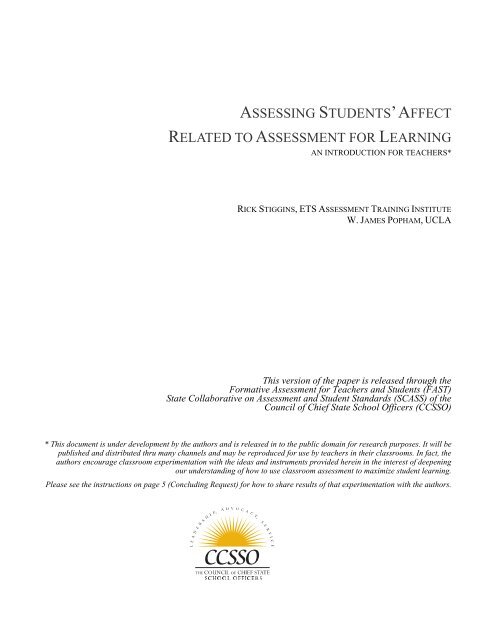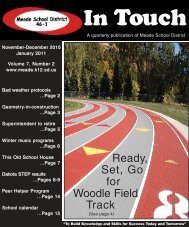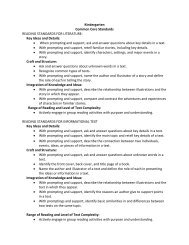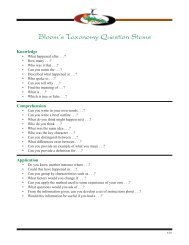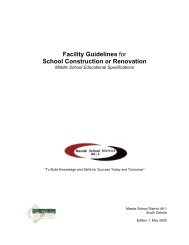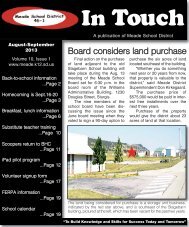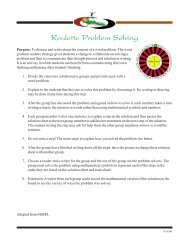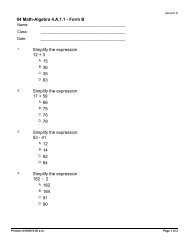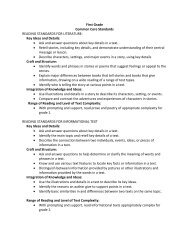Assessing Students' Affect Related to Assessment for Learning
Assessing Students' Affect Related to Assessment for Learning
Assessing Students' Affect Related to Assessment for Learning
You also want an ePaper? Increase the reach of your titles
YUMPU automatically turns print PDFs into web optimized ePapers that Google loves.
THE COUNCIL OF CHIEF STATE SCHOOL OFFICERSThe Council of Chief State School Officers (CCSSO) is a nonpartisan, nationwide, nonprofit organization of public officialswho head departments of elementary and secondary education in the states, the District of Columbia, the Department ofDefense Education Activity, and five U.S. extra‐state jurisdictions. CCSSO provides leadership, advocacy, and technicalassistance on major educational issues. The Council seeks member consensus on major educational issues and expresses theirviews <strong>to</strong> civic and professional organizations, federal agencies, Congress, and the public.Formative <strong>Assessment</strong> <strong>for</strong> Students and Teachers State Collaborative on <strong>Assessment</strong> and Student StandardsThe Council’s State Collaborative on <strong>Assessment</strong> and Student Standards (SCASS) strives <strong>to</strong> provide leadership, advocacy andservice in creating and supporting effective collaborative partnerships through the collective experience and knowledge ofstate education personnel <strong>to</strong> develop and implement high standards and valid assessment systems that maximize educationalachievement <strong>for</strong> all children.COUNCIL OF CHIEF STATE SCHOOL OFFICERSRick Melmer (South Dakota), PresidentElizabeth Burmaster (Wisconsin), Past PresidentT. Kenneth James (Arkansas), President‐ElectGene Wilhoit, Executive Direc<strong>to</strong>rJohn Tanner, Direc<strong>to</strong>r Center <strong>for</strong> Innovative MeasuresDuncan MacQuarrie and Douglas Rindone, Co‐Coordina<strong>to</strong>rs, FAST SCASSCouncil of Chief State School OfficersOne Massachusetts Avenue, NW, Suite 700Washing<strong>to</strong>n, DC 20001‐1431Phone (202) 336‐7000Fax (202) 408‐8072www.ccsso.org
<strong>Assessing</strong> Student’s <strong>Affect</strong> <strong>Related</strong> <strong>to</strong> <strong>Assessment</strong> <strong>for</strong> <strong>Learning</strong>W. James Popham and Rick StigginsASSESSING STUDENTS’ AFFECTRELATED TO ASSESSMENT FOR LEARNINGAN INTRODUCTION FOR TEACHERS*Rick Stiggins, ETS <strong>Assessment</strong> Training InstituteW. James Popham, UCLA<strong>Assessment</strong> <strong>for</strong> learning (AFL) represents a way <strong>for</strong>teachers and their students <strong>to</strong> employ the assessmentprocess and its results instructionally in their classrooms.Ample research evidence indicates that AFL, if properlyimplemented, will improve students’ mastery of what’sbeing taught in class and, thus, is apt <strong>to</strong> enhanceper<strong>for</strong>mance on external achievement tests dealing with thatcontent (Black and Wiliam, 1998a, 1998b). However,because AFL is, in many ways, a particularly strongstudent-focused approach <strong>to</strong> instruction, an approach inwhich students become personally involved in moni<strong>to</strong>ringand adjusting how they are attempting <strong>to</strong> learn, thisachievement-enhancing assessment strategy is almostcertain <strong>to</strong> also have an impact on students’ affect, that is,their personal perceptions and predispositions about theirlearning. Indeed, when employed properly, AFL uses thoseperceptions and predispositions <strong>to</strong> drive learningproductively <strong>for</strong>ward.One of the corners<strong>to</strong>nes of AFL is that both teachersand students must maintain an ongoing picture of students’achievement progress based on a variety of <strong>for</strong>mal andin<strong>for</strong>mal assessment tactics. Frequent assessments providethe kind of continuous feedback that teachers need <strong>to</strong>determine what comes next in the student’s learning, andthat students need <strong>to</strong> learn how <strong>to</strong> do better the next time.Frequent feedback, there<strong>for</strong>e, contributes <strong>to</strong> the student’ssuccess which feeds a growing sense of confidence. Yet,teachers who currently implement AFL have no systematicway of discerning the affective impact of this approach ontheir students. In an ef<strong>for</strong>t <strong>to</strong> provide teachers with <strong>to</strong>ols <strong>for</strong>tracking students’ affect related <strong>to</strong> AFL, we have developedthree age-appropriate affective inven<strong>to</strong>ries <strong>for</strong> use byteachers who wish <strong>to</strong> discern the impact of their instructionon those affective dispositions most likely <strong>to</strong> be influencedby an AFL approach. All three inven<strong>to</strong>ries (grades 3-6, 7-9,and 10-12) are appended <strong>to</strong> this introduction.We understand that concern <strong>for</strong> student affect certainlyis relevant in the primary grades <strong>to</strong>o. However, inquiriesin<strong>to</strong> the matters addressed herein are best handled throughdirect personal interaction between teachers and theirstudents. Inven<strong>to</strong>ries such as those presented in theAppendix are used most productively beginning in earlyelementary grades.Two <strong>Affect</strong>ive FociTwo affective variables are especially likely <strong>to</strong> beinfluenced by teachers who employ AFL in their classes:academic efficacy and eagerness <strong>to</strong> learn.Academic efficacy. Academic efficacy refers <strong>to</strong> astudent’s perceived ability <strong>to</strong> succeed and the student’ssense of control over her or his academic well being. If anAFL class is working the way it should, most students willreceive instructional tasks that coincide well with theircurrent achievement levels. As a consequence, thosestudents are apt <strong>to</strong> be successful in learning what they aresupposed <strong>to</strong> learn so that ongoing assessments will providethem with evidence of their success. Even moreimportantly, through the use of <strong>for</strong>matively-orientedassessments, initially unsuccessful students will bereceiving guidance regarding how <strong>to</strong> adjust their learningtactics so that they will ultimately become successful.Accordingly, if an AFL classroom is functioningappropriately, students’ perceptions of their personalacademic prowess should (1) remain high or (2) improvesubstantially if such perceptions begin at a low level. Inother words, students’ sense of academic efficacy should,there<strong>for</strong>e, remain strong or become stronger as time goesby. If this is not occurring, then a teacher might wish <strong>to</strong>consider implementing efficacy-enhancing instructionalsuggestions such as those offered on pages 4 and 5.Eagerness <strong>to</strong> learn. A second affective variableassociated with an AFL instructional approach is students’eagerness <strong>to</strong> learn. Clearly, teachers would like students no<strong>to</strong>nly <strong>to</strong> believe they are capable of learning (as representedby students’ academic efficacy) but teachers would also likestudents <strong>to</strong> want <strong>to</strong> learn. Ideally, if AFL is working the wayit is supposed <strong>to</strong> work, students’ eagerness <strong>to</strong> learn willThis version released through The Council of Chief State School Officers1The FAST SCASS • Formative <strong>Assessment</strong> <strong>for</strong> Students and Teachers
<strong>Assessing</strong> Student’s <strong>Affect</strong> <strong>Related</strong> <strong>to</strong> <strong>Assessment</strong> <strong>for</strong> <strong>Learning</strong>W. James Popham and Rick Stigginsremain high or will increase over time. That’s because AFLtaughtstudents will be experiencing a series of successfullearning experiences. Most human beings enjoy doing whatthey are good at doing. This is also true with students inschool. When students are good at learning things, most ofthem will be inclined <strong>to</strong> want <strong>to</strong> learn more things.As was the case with academic efficacy, if students arenot becoming more eager <strong>to</strong> learn, then the teacher needs <strong>to</strong>consider suggestions aimed at increasing students’eagerness <strong>to</strong> learn such as those presented on pages 4 and 5.Although there are surely other affective consequencesthat might emerge from the effective implementation of anAFL class, we believe the most significant are the twoaffective dimensions just described, namely, students’academic efficacy and their eagerness <strong>to</strong> learn. There shouldbe a definite strengthening of both of these affectivevariables during an extended period of AFL instruction.<strong>Affect</strong>ive <strong>Assessment</strong><strong>Assessment</strong> of students’ affective variables such asthese two presents unique challenges. For example, <strong>to</strong>assess affect productively, teachers must elicit honestresponses from students. Teachers want <strong>to</strong> know howstudents really feel. But in an environment in whichstudents have learned <strong>to</strong> give teachers the “right” answers(that is, the answers students believe the teacher wants <strong>to</strong>hear) there is a danger that students will tend <strong>to</strong> supplysocially desirable responses. Obviously, such responses canbe misleading. To prevent this, affective inven<strong>to</strong>ries such asthose offered in the appendix must be administered underconditions of absolute anonymity. Not only do studentsmake all responses <strong>to</strong> an affective inven<strong>to</strong>ry anonymously,but those students must really believe their anonymousresponses are untraceable. Only then can teachers hope <strong>for</strong>honest expressions of students’ sentiments.This requirement <strong>for</strong> anonymity carries with itimportant implications <strong>for</strong> how the inven<strong>to</strong>ries can be used.Unlike the assessment of students’ cognitive achievement,in which teachers arrive at an assessment-based inferenceabout each student’s level of achievement, affectiveassessment permits teachers <strong>to</strong> make only group-basedinferences about students’ affect. Yet, by calculating anaverage per-student response from an entire class ofstudents, a sufficiently accurate group-focused inference canbe made <strong>to</strong> guide the teacher of that class. Some students, ofcourse, even though providing only anonymous responses,will still supply excessively positive responses because theybelieve their teacher will want them <strong>to</strong> answer in that way.Yet, there are also some students who will supplyexcessively negative responses because—shrouded by acloak of anonymity—they believe this is an opportunity <strong>to</strong>“get even” with the teacher. Thus, the average of allstudents’ responses <strong>to</strong> an anonymous self-report inven<strong>to</strong>rytypically supplies a sufficiently accurate estimate (<strong>for</strong> ateacher’s decision-making) regarding the affective status ofan entire class.The Inven<strong>to</strong>riesEach of the grade-range inven<strong>to</strong>ries contains eightstatements with which students are asked <strong>to</strong> agree ordisagree. Two of the statements in each inven<strong>to</strong>ry focus on astudent’s academic efficacy. The two statements below(taken from the grade 7-9 inven<strong>to</strong>ry) are intended <strong>to</strong> elicitstudents’ perceptions of their own academic efficacy:o When I’m asked <strong>to</strong> learn something new in thisclass, even if it’s difficult, I know I can learn it.(Item 2)o Even with help and plenty of time, I’m going <strong>to</strong>have difficulty learning new things in this class.(Item 7)Two more statements from the grade 7-9 inven<strong>to</strong>ry dealwith a student’s eagerness <strong>to</strong> learn:o I’m really excited about learning new things in thisclass. (Item 4)o Most of the time I don’t look <strong>for</strong>ward <strong>to</strong> learningnew things in this class. (Item 6)In each of these two pairs of statements, one statementis phrased positively and one statement is phrasednegatively. Thus, <strong>for</strong> example, students who are eager <strong>to</strong>learn would tend <strong>to</strong> agree with the positively phrasedstatement, but disagree with the negatively phrasedstatement. (Considerable experience in the construction ofthese sorts of self-report inven<strong>to</strong>ries suggests that this sor<strong>to</strong>f positive-and-negative phrasing yields the most accurateindication of students’ true sentiments.)In addition, each of the inven<strong>to</strong>ries includes two itemsdealing with a key feature of an AFL classroom: clarity oflearning targets:o I usually have a pretty good idea about what I amexpected <strong>to</strong> learn in this class. (Item 1)o In this class I often don’t have a clear idea aboutwhat I am supposed <strong>to</strong> be learning. (Item 5)Another pair if items focus on a second importantattribute of an AFL classroom, namely, the degree <strong>to</strong> whichteachers provide their students with progress-moni<strong>to</strong>ringin<strong>for</strong>mation:o Typically, I don’t have a very good idea if I ammaking enough progress in this class. (Item 3)o In this class, I get enough in<strong>for</strong>mation <strong>to</strong> keepaccurate track of my own achievement. (Item 8)These four statements do not focus directly on students’affect per se. Rather, they center on the students’perceptions about practices carried out by their teacher.These two pairs of statements are included because mostteachers who are attempting <strong>to</strong> implement an AFL class willwish <strong>to</strong> know the degree <strong>to</strong> which their students believethese two focal aspects of AFL are, from the students’perspective, taking place.This version released through The Council of Chief State School Officers2The FAST SCASS • Formative <strong>Assessment</strong> <strong>for</strong> Students and Teachers
<strong>Assessing</strong> Student’s <strong>Affect</strong> <strong>Related</strong> <strong>to</strong> <strong>Assessment</strong> <strong>for</strong> <strong>Learning</strong>W. James Popham and Rick StigginsSuggested Uses of the Inven<strong>to</strong>riesThese affective inven<strong>to</strong>ries are intended exclusively <strong>for</strong>teachers <strong>to</strong> use as instructionally relevant evidence-eliciting<strong>to</strong>ols in their classrooms, and only if a teacher individuallydecides <strong>to</strong> do so. The inven<strong>to</strong>ries are not designed <strong>for</strong>evaluative purposes at either the teacher-level or schoollevel.Indeed, as will be suggested later, the inven<strong>to</strong>ries arespecifically constructed so they can be modified <strong>to</strong> meshbetter with a particular instructional context and a giventeacher’s interests in students’ affect.If a teacher wishes <strong>to</strong> collect in<strong>for</strong>mation regardingshifts in students’ affect during the course of a school year,and want <strong>to</strong> submit such affective data <strong>for</strong> personnelevaluationpurposes, this would clearly be the teacher’schoice. The purpose of the three affective inven<strong>to</strong>riesprovided in the Appendix is <strong>to</strong> assist teachers in determiningwhether classroom implementation of AFL is having thedesired impact on students’ affect.One relatively simple and straight<strong>for</strong>ward use of anaffective inven<strong>to</strong>ry in an AFL class is <strong>for</strong> the teacher <strong>to</strong>administer it on a pre-instruction and post-instruction basis,<strong>for</strong> instance, at the beginning and end of an instructionalunit, a grading period, semester, or school year, dependingon the context. A contrast between such pre-instruction andpost-instruction results will allow a teacher <strong>to</strong> determine ifany meaningful improvements have taken place in, <strong>for</strong>example, students’ academic efficacy.However, because AFL teachers are typically attentive<strong>to</strong> the ongoing nature of instruction in their classes, thissuggests that a more fruitful use of these affectiveinven<strong>to</strong>ries would involve their administration several timesduring instruction. By so doing, of course, teachers wouldthen have time <strong>to</strong> make adjustments in what they weredoing based on class-focused inferences about students’affect and students’ reactions <strong>to</strong> what is taking place in class(with respect <strong>to</strong> the two statements about clarity ofexpectations and the two statements about progressmoni<strong>to</strong>ringin<strong>for</strong>mation). Care should be taken not <strong>to</strong>administer these inven<strong>to</strong>ries so frequently over a shortperiod of time that students become jaded about excessiveuse of the inven<strong>to</strong>ries.Still another approach might be <strong>to</strong> use the inven<strong>to</strong>riesstrategically. That is, if a teacher senses that things aren’tgoing well and students’ reactions <strong>to</strong> instructional activitiesare not sufficiently positive, responses <strong>to</strong> an inven<strong>to</strong>ry mightprovide some insight in<strong>to</strong> why this is the case. Results mightpoint <strong>to</strong> AFL actions teachers might take <strong>to</strong> get studentsback on track.Modifying the Inven<strong>to</strong>riesThese public-domain inven<strong>to</strong>ries are provided <strong>for</strong>teachers <strong>to</strong> use without restriction. There is nothingsacrosanct about the nature of the items in the inven<strong>to</strong>ries inthe Appendix, so teachers should feel free not only <strong>to</strong>modify the current items, but also <strong>to</strong> add or delete items. Forexample, if an elementary teacher happened <strong>to</strong> beparticularly interested in students’ interests in reading or,perhaps, in social studies, then statements such as thefollowing might be added <strong>to</strong> the items: “Lots of the time Iwould rather read than watch TV.” or “I really like it whenour class deals with social studies.” (Ideally, items shouldbe added in pairs so that one statement is phrased positivelyand another statement is phrased negatively.) Because theseinven<strong>to</strong>ries are intended <strong>to</strong> help an individual teacher do agood instructional job, teachers should modify theinstruments as they wish.Directions <strong>for</strong> AdministrationDuring our pilot-testing of early versions of theseinven<strong>to</strong>ries during their development, both teachers andstudents suggested that the Directions (<strong>to</strong> students) on theinven<strong>to</strong>ries themselves should be extremely brief, and thatthe teacher should give the bulk of the directions orally.There<strong>for</strong>e, as you will note on the inven<strong>to</strong>ries, the directions<strong>to</strong> the student are quite abbreviated. It is suggested that ateacher read (aloud) something along these lines <strong>to</strong> studentsprior <strong>to</strong> each administration of one of these affectiveinven<strong>to</strong>ries:Today I want you <strong>to</strong> complete a brief inven<strong>to</strong>rydealing with this class—and only this class. Youwill complete the inven<strong>to</strong>ry’s items anonymously,so just enter your responses—don’t put your nameon the inven<strong>to</strong>ry or write anything else. There willbe no way <strong>to</strong> tell how you responded, so pleaseanswer as honestly as you can. I will be using theaverage responses of the entire class <strong>to</strong> help me doa good job of teaching. That is the only reason Iam asking you <strong>to</strong> fill out this inven<strong>to</strong>ry.There is a sample of how you are <strong>to</strong> respond givenat the <strong>to</strong>p of the inven<strong>to</strong>ry. As you can see, you are<strong>to</strong> circle the response-letters <strong>for</strong> the itemsdepending on how you personally feel about eachstatement.When you are finished, please place yourcompleted inven<strong>to</strong>ry in the collection envelopethat has been provided. Thank you <strong>for</strong> helping mewith this.If the teacher is administering an inven<strong>to</strong>ry on morethan one occasion, there would be slight variations in thisset of oral directions such as, “Today I need you <strong>to</strong> oncemore complete the brief, anonymous inven<strong>to</strong>ry that you<strong>to</strong>ok several months ago, etc.”If there is a more appropriate way <strong>for</strong> students <strong>to</strong> returntheir inven<strong>to</strong>ries, such as by depositing the completedinven<strong>to</strong>ries in a collection box provided <strong>for</strong> that purpose,this <strong>to</strong>o would need <strong>to</strong> be noted. The idea of having theteacher supply oral directions <strong>for</strong> these inven<strong>to</strong>ries is thatthose directions can be suitably tailored <strong>to</strong> the teacher’sinstructional situation.This version released through The Council of Chief State School Officers3The FAST SCASS • Formative <strong>Assessment</strong> <strong>for</strong> Students and Teachers
<strong>Assessing</strong> Student’s <strong>Affect</strong> <strong>Related</strong> <strong>to</strong> <strong>Assessment</strong> <strong>for</strong> <strong>Learning</strong>W. James Popham and Rick StigginsScoring the Inven<strong>to</strong>riesRemember, results should be compiled <strong>for</strong> the class as awhole so as <strong>to</strong> identify patterns or, over time, trends inresponses. One easy procedure is <strong>to</strong> determine the numberof students who select each response <strong>to</strong> each item. Thisprocedure may work best when the teacher is just doing aquick check <strong>to</strong> determine the current state of affairs in theclass. Then make a simple bar graph <strong>for</strong> each item. How dothe students’ responses distribute themselves along the“agreement-disagreement” response scale? The patterns willusually reveal students’ sentiments. .But if the teacher seeks <strong>to</strong> track changes in students’affect over time, frequency counts and bar graphs can beclumsy. It is typically better in that case <strong>to</strong> calculate averageratings so the teacher can detect changes in students’ scoresover time. To convert the frequency counts <strong>to</strong> averagescores, simply multiply the score (1 <strong>to</strong> 5) by its frequency,add the resulting calculations across scores and divide bythe <strong>to</strong>tal number of students responding. This should bedone <strong>for</strong> each individual item separately.To compute an academic efficacy score based on thecombined positively and negatively stated items, rememberthat scores on a positively stated item go from 1 <strong>for</strong> astrongly-disagree response <strong>to</strong> a 5 <strong>for</strong> a strongly agreeresponse. But on a negatively phrased item, the scale isreversed. The higher the score, the more “appropriate” is theresponse. Because there are two items per variable, a pervariablescore can range from a low of two points <strong>to</strong> a highof ten points. Here is a graphic illustration of the scoregeneratingprocess:Item Rating scale Combined <strong>for</strong> each score1 5 4 3 2 1 Clarity of <strong>Learning</strong> Targets2 5 4 3 2 13 1 2 3 4 5 Eagerness <strong>to</strong> Learn4 5 4 3 2 15 1 2 3 4 5 Academic Efficacy6 1 2 3 4 57 1 2 3 4 5 Progress Moni<strong>to</strong>ring8 5 4 3 2 1 In<strong>for</strong>mationAdjusting Instruction Based on ResultsWe begin this section with two cautions. First, thestrategies suggested <strong>for</strong>m the foundation of an AFLclassroom. The vast majority of teachers have not been giventhe opportunity <strong>to</strong> learn how <strong>to</strong> create such environments.The creation of an AFL requires a fundamentalunderstanding of several principles that we can merelyhighlight herein. Those interested in further study of theprinciples, strategies, and tactics outlined below shouldconsult one or more of the numerous articles and books nowbeing published regarding AFL.Second, we assume that the teacher’s (inven<strong>to</strong>ry-user’s)goal is <strong>to</strong> help the largest possible proportion of theirstudents meet pre-specified academic achievementstandards. That is, the mission is <strong>to</strong> maximize studentsuccess. The AFL suggestions offered below can have thatimpact. If the teacher’s mission is something other, such as<strong>to</strong> produce a dependable rank order of students at the end ofinstruction, the suggestions offered may becounterproductive.If an inven<strong>to</strong>ry’s results suggest that students’ sense ofacademic efficacy is lower than desired on the basis of asingle administration of a grade-appropriate inven<strong>to</strong>ry, or isnot tending upward on repeated measures over time, theninstructional actions need <strong>to</strong> help students gain a sense ofcontrol over their learning success. This requires thatclassroom practices get students on academic “winningstreaks” and keep them there. Six specific strategies appliedin this order can help with this:1. Provide learners with student-friendly versions ofthe achievement targets from the very beginning ofinstruction.<strong>Learning</strong> accelerates when teachers describe what goodwork looks like using vocabulary that learners canunderstand. Students can hit any target that they can see andthat holds still <strong>for</strong> them. With clear signposts be<strong>for</strong>e them,students can watch themselves progressing ever closer <strong>to</strong>success. This builds confidence. When this frame ofreference is missing <strong>for</strong> them, students can lose their wayand their ability <strong>to</strong> find the path <strong>to</strong> success. Obviously, thissuggestion places a premium on teachers’ having clear andappropriate achievement expectations, that is, the suggestiondepends on teachers’ knowing where they’re going.2. Accompany those expectations with samples ofstudent work that reveal <strong>to</strong> students, from thebeginning of the learning, what their work will looklike as it improves.Those samples should cover the full range, includingweak, mid-range, and high-quality work. Again, this allowslearners <strong>to</strong> evaluate where they are at any time on thecontinuum of achievement in relation <strong>to</strong> where teachers wantThis version released through The Council of Chief State School Officers4The FAST SCASS • Formative <strong>Assessment</strong> <strong>for</strong> Students and Teachers
<strong>Assessing</strong> Student’s <strong>Affect</strong> <strong>Related</strong> <strong>to</strong> <strong>Assessment</strong> <strong>for</strong> <strong>Learning</strong>them <strong>to</strong> be. As students see the fruits of their ef<strong>for</strong>ts inlearning results, academic efficacy grows.3. Provide students with continuous access <strong>to</strong>descriptive feedback, that is, with feedback showingthem now <strong>to</strong> do better the next time.In effect, this suggestion gives students control in the<strong>for</strong>m of the in<strong>for</strong>mation needed <strong>to</strong> keep them moving alongthe learning progression relevant <strong>to</strong> the achievement targetbeing pursued. Teachers should want their students <strong>to</strong> winearly, win small, and win often. Winning streaks becometrajec<strong>to</strong>ries that take on a life of their own. Confidence andoptimism grow. And, of course, teachers must be sure thatclassroom assessments are of sufficient quality <strong>to</strong> provideteachers and their students with accurate in<strong>for</strong>mation.4. Teach students <strong>to</strong> self assess so they can begin <strong>to</strong>generate their own descriptive feedback.This suggestion requires that students learn <strong>to</strong> apply thevery same per<strong>for</strong>mance criteria their teachers apply whenevaluating students’ work. By getting students <strong>to</strong> play a rolein this process, teachers set students up <strong>to</strong> become partners indetermining what comes next in their learning, that is, insetting goals and in defining success. This contributes <strong>to</strong>students’ sense of control over their success.5. Help students learn <strong>to</strong> improve their work one keyattribute of success at a time.By not overwhelming students with <strong>to</strong>o many neededimprovements, teachers can help their students succeed bytaking baby steps and, continuously, building an internalsense of control over their success. Winning streaks feelgood, and this builds confidence.6. Teach students <strong>to</strong> reflect on changes(improvements) in the quality of their work and whythose improvements have happened.This suggestion represents the culmination of what isaccomplished by applying Suggestions 1 <strong>to</strong> 5 above. Bydeveloping an understanding of the key attributes of goodwork as reflected in actual samples of that work, teachersgive students the <strong>to</strong>ols needed <strong>to</strong> see key changes inW. James Popham and Rick Stigginsstudents’ own work. By giving descriptive feedback, one keyattribute at a time, and helping students learn <strong>to</strong> generatetheir own feedback, teachers give students a mirror in which<strong>to</strong> see themselves climbing <strong>to</strong>ward success. All of this putsstudents in <strong>to</strong>uch with their own evolving academiccapabilities. In effect, success becomes its own reward.With the resulting sense that success is, in fact, withinreach, students’ academic efficacy and eagerness <strong>to</strong> learnwill increase. But the foundational conditions are thatstudents be in <strong>to</strong>uch with the targets from the beginning ofthe learning, and that students have access <strong>to</strong> their owncontinuous record of assessment results so they navigate thepath <strong>to</strong> success and watch themselves arriving there. It issurprising how effectively success builds eagerness <strong>for</strong> moresuccess.Concluding RequestThe current version of these introduc<strong>to</strong>ry remarks andthe three affective inven<strong>to</strong>ries are being distributed on alimited basis with the hope that some educa<strong>to</strong>rs may choose<strong>to</strong> employ them and, based on those experiences, relaysuggestions <strong>to</strong> us regarding how <strong>to</strong> improve either theinven<strong>to</strong>ries themselves or the introduction <strong>to</strong> their use. If youhave suggestions, please relay them <strong>to</strong> : rstiggins@ets.org orwpopham@ucla.edu.ReferencesBlack, P. and D. Wiliam (1998a). “<strong>Assessment</strong> andClassroom <strong>Learning</strong>,” <strong>Assessment</strong> in Education:Principles, Policy and Practice 5(1): 7-73; alsosummarized in “Inside the Black Box: RaisingStandards through Classroom <strong>Assessment</strong>,” PhilDelta Kappan. 80(2), 139-148.This version released through The Council of Chief State School Officers5The FAST SCASS • Formative <strong>Assessment</strong> <strong>for</strong> Students and Teachers
<strong>Assessing</strong> Student’s <strong>Affect</strong> <strong>Related</strong> <strong>to</strong> <strong>Assessment</strong> <strong>for</strong> <strong>Learning</strong>W. James Popham and Rick StigginsTHE WAY I SEE SCHOOLInven<strong>to</strong>ry <strong>for</strong> Grades 7-9Directions: Please indicate how you feel about each statement below as follows:SA = Strongly Agree A = Agree U = Uncertain D = Disagree SD = Strongly DisagreeFor example, here is how you would respond if you agree with the statement at the left:I like <strong>to</strong> watch TV. SA A U D SDWhen you complete the <strong>for</strong>m, please place it in the large collection-envelope that’s provided.1. I usually have a pretty good idea about what I amexpected <strong>to</strong> learn in this class.2. When I’m asked <strong>to</strong> learn something new in thisclass, even if it’s difficult, I know I can learn it.3. Typically, I don’t have a very good idea if I ammaking enough progress in this class.4. I’m really excited about learning new things in thisclass.5. I often don’t have a clear idea in this class aboutwhat I am supposed <strong>to</strong> be learning.6. Most of the time, I don’t look <strong>for</strong>ward <strong>to</strong> learningnew things in this class.7. Even with help and plenty of time, I’m going <strong>to</strong> havedifficulty learning new things in this class.8. In this class, I get enough in<strong>for</strong>mation <strong>to</strong> keep trackof my own learning achievement.SA A U D SDSA A U D SDSA A U D SDSA A U D SDSA A U D SDSA A U D SDSA A U D SDSA A U D SDThank you <strong>for</strong> completing this <strong>for</strong>mThis version released through The Council of Chief State School Officers7The FAST SCASS • Formative <strong>Assessment</strong> <strong>for</strong> Students and Teachers
<strong>Assessing</strong> Student’s <strong>Affect</strong> <strong>Related</strong> <strong>to</strong> <strong>Assessment</strong> <strong>for</strong> <strong>Learning</strong>W. James Popham and Rick StigginsTHE WAY I SEE SCHOOLInven<strong>to</strong>ry <strong>for</strong> Grades 10-12Directions: Please indicate how you feel about each statement below as follows:SA=Strongly Agree A=Agree U=Uncertain D=Disagree SD=Strongly DisagreeFor example, here is how you would respond if you agree with the statement at the left:I like <strong>to</strong> watch TV. SA A U D SDWhen you complete the <strong>for</strong>m, please place it in the large collection-envelope that’sprovided.1. On most days, I have a pretty good idea about what Iam expected <strong>to</strong> learn in this class.2. If I’m asked <strong>to</strong> learn something brand new in thisclass, even if it’s difficult, I know I can do so.3. I often don’t have a good idea if I am achievingacademically as fast as I should in this class.4. I’m almost always excited about learning genuinelynew things in this class.5. More often than not, I don’t have a good idea if I amprogressing properly in this class.6. Most of the time, I actually don’t look <strong>for</strong>ward <strong>to</strong>learning new things in this class.7. Even with much help and plenty of time, I think I’llhave trouble learning new things in this class.8. In this class, I get plenty of in<strong>for</strong>mation so I can keeptrack of my own academic progress.SA A U D SDSA A U D SDSA A U D SDSA A U D SDSA A U D SDSA A U D SDSA A U D SDSA A U D SDThank you <strong>for</strong> completing this <strong>for</strong>mThis version released through The Council of Chief State School Officers8The FAST SCASS • Formative <strong>Assessment</strong> <strong>for</strong> Students and Teachers


